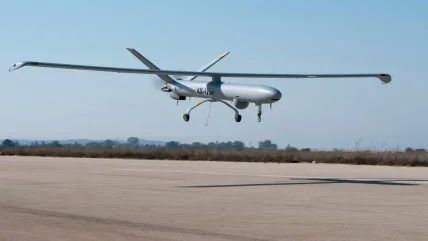
For unmanned aircraft system (UAS) missions, having an up-to-date operational picture is a crucial aspect of efficient planning and management. At its core, Carmenta provides a robust software development kit (SDK) that provides geospatial capabilities for customer applications, taking data from a variety of static and dynamic sources – radar feeds, video streams from drones or tactical overlays, and so on.
From there, this data is analysed in order to derive useful, meaningful information for the end-user. This could involve a number of different run-time types of analysis like line-of-sight, projected video or different forms of UAS routing – for example, to avoid buildings, restricted areas and other UAS routes in an airspace.
“This is also all done in real time, so it’s always something that can be updated if the feed of different sensor information changes,” adds Jonas Envall, business development director, UAS, and senior project director at Carmenta. All of this information, combined together, helps provide greater situational awareness for the user. One use case for the company’s geospatial software solutions could involve evaluating safe landing zones for UASs, which might be required for military delivery or resupply missions. Here, Carmenta’s software identifies useful information from sources like terrain data or land data – the former noting the slope of nearby terrain, while the latter would identify nearby features such as roads, swamps or forested areas. Together, this information would be combined with safety distance data to find suitable landing areas and combined with more dynamic sensor data to get up-to-date information – ensuring that safe landing is possible during the entirety of the mission.
However, the operational picture Carmenta’s software provides depends on the scenario at hand – more specifically, on the mission objective. A military operation, for example, might prioritise stealth, and instruct the UAS to fly close to the terrain to avoid being seen. A visibility index analysis would identify the enemy’s blind spots, using terrain like nearby hills or mountains to the UAS’s advantage.
Putting plans into practice
Carmenta is involved in Project HADO – which stands for High-intensity Autonomous Drone Operations – working alongside UK-based partners on a two-year programme, funded by the Future Flight Challenge and UK Research and Innovation, and aimed at helping the UK lead in autonomous drone operations across next-generation airspace.
“For this particular project, we’re going to fly autonomous beyond-visual-line-ofsight (BVLOS) drones at Heathrow Airport next summer,” says Envall. Carmenta will be responsible for providing advanced dynamic real-time geospatial analysis and advanced UAS routing capabilities, enabling multiple drones to fly at the same time in the Heathrow airspace. That’s not to say that Carmenta’s geospatial solutions are only useful for UASs, of course. “Drones are one of our technology focus areas, but our technology is equally suitable and used for unmanned ground and surface vehicles (UGVs and USVs),” notes Envall.
Similarly, Carmenta’s products and the situational awareness they provide can be invaluable when it comes to Counter UAS (CUAS), enabling the early detection of enemy drones by making use of data like radar and camera coverage. The wide range of tasks that the company’s software can be adapted to highlights one of its key values – providing flexibility and adaptability for its users.
“We are agnostic with regards to which operating system that customers use,” notes Envall, stressing that maintaining ease-of-use and approachability is a key part of Carmenta’s solutions. “We run on Linux, Windows, Android and iOS. All the data formats that any customer can bring, we can read.”
find out more please click here to download the white paper.



